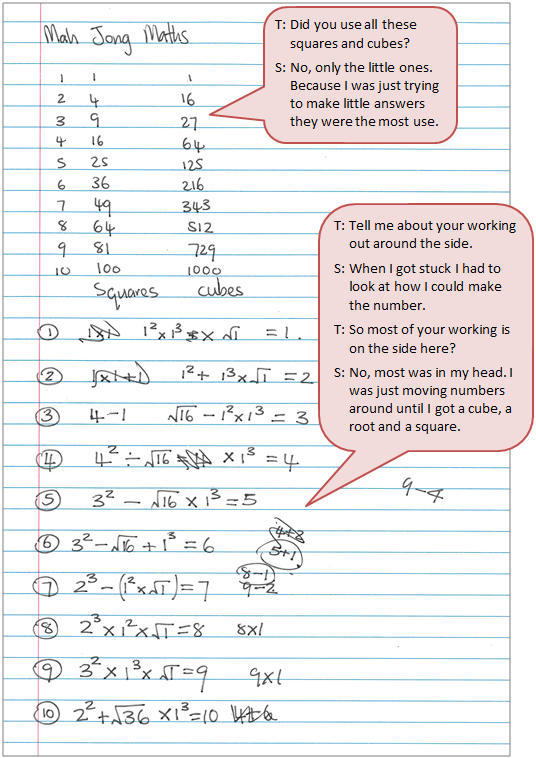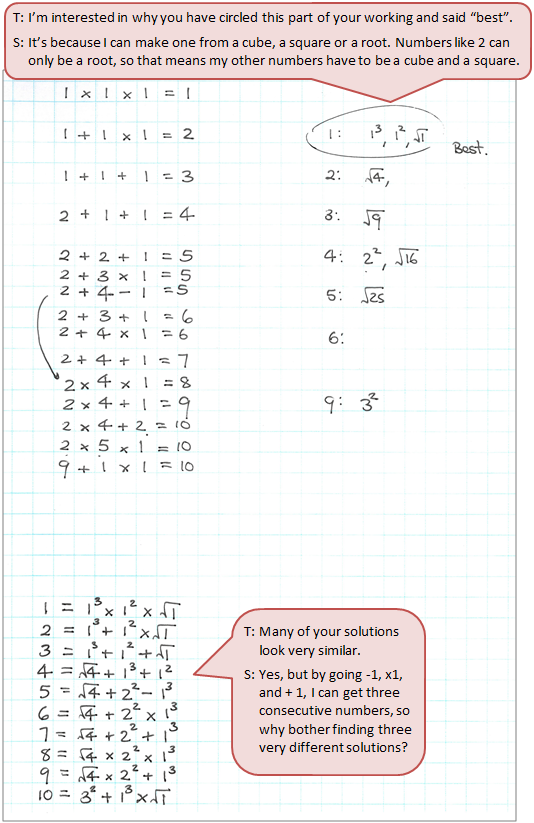It sounds like Mah Jong
The purpose of this activity is to engage students in using the order of operations and knowledge of squares, cubes and roots, to solve a problem.
This activity assumes the students have experience in the following areas:
- Finding squares and cubes or whole numbers, and square roots.
- Applying the correct order of operations.
- Writing a target number as the sum or product of other numbers.
The problem is sufficiently open ended to allow the students freedom of choice in their approach. It may be scaffolded with guidance that leads to a solution, and/or the students might be given the opportunity to solve the problem independently.
The example responses at the end of the resource give an indication of the kind of response to expect from students who approach the problem in particular ways.
Task: The game of mah jong requires the players to make up hands that have names such as 'a run, a pung and a pair'. As a mathematical equivalent, can you make up the first ten natural (counting) numbers from a cube, a square and a root?
The following prompts illustrate how this activity can be structured around the phases of the Mathematics Investigation Cycle.
Make sense
Introduce the problem. Allow students time to read it and discuss in pairs or small groups.
- Do I understand all the words, or should I ask for help? (Are students familiar with the terms counting numbers, squares, cubes, and square roots?)
- What operations could I use? Do I have to use only addition?
- What would be a good way to start the problem? (Experimenting to find isolated solutions to some numbers may not be as productive as beginning in an organised way.)
- Will there be many ways to express each number?
Plan approach
Discuss ideas about how to solve the problem. Emphasise that, in the planning phase, you want students to say how they would solve the problem, not to actually solve it.
- What are the maths skills I need to work this out?
- What information will be useful? Can I create or access a list of squares, cubes, and square roots?
- How could I organise my work, so I learn from each example? How can I record what I do?
- What strategies can I use to get started? (A table of results will be very useful.)
- Do I expect that there will be patterns in my answers? What kinds of patterns?
- What tools (digital or physical) could help my investigation?
Take action
Allow students time to work through their strategy and find a solution to the problem.
- Have I worked systematically to record my results?
- How can we share the mahi in our group to get the best result?
- How could I make sure that I haven’t missed anything?
- Are there any patterns I can use to get expressions for other numbers?
- How might I describe the patterns?
- How do my results look different to others? Why could this be? Which expression looks best? Why?
- Is there another way to find expressions that is more productive?
Convince yourself and others
Allow students time to check their answers and then either have them pair share with other groups or ask for volunteers to share their solution with the class.
- Are my expressions clearly recorded?
- Are my expressions correct?
- Which ideas or tools worked well in my investigation?
- How did I build on things I knew to find out things I did not know?
- What could I find out next? Could I include other sets of numbers, like primes?
- Is there some mathematics that I need to work on?
- How could I use my results to find expressions for other numbers?
Examples of work
Work sample 1
The student creates expressions for each of the numbers 1 through to 10, by combining cubes, squares and roots. The student employs an approach of 'guess and check' to form and to amend solutions.
Click on the image to enlarge it. Click again to close.
Work sample 2
The student creates expressions for each of the numbers 1 through to 10, by combining cubes, squares and roots and explains their strategy or strategies.


